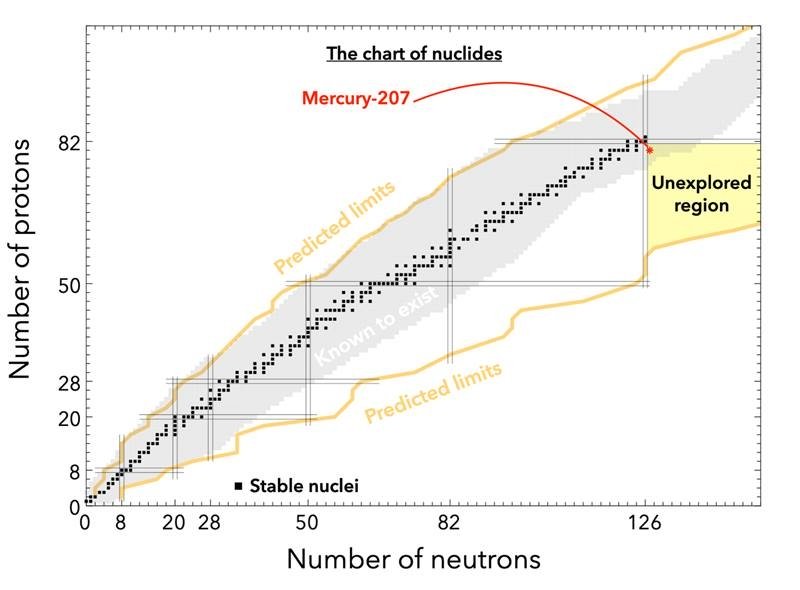The Science
The nuclei of atoms consist of protons and neutrons held together by a force called nuclear binding energy. The nuclei of some isotopes with a specific number of protons and neutrons are more tightly bound than isotopes with more or fewer protons or neutrons. This means these isotopes’ nuclei require more energy to disassemble into protons and neutrons. These specific numbers of neutrons or protons are 2, 8, 20 28, 50, 82, and 126. Scientists are particularly interested in nuclei with fewer than 82 protons and more than 126 neutrons. Isotopes that differ by one proton or neutron from these magic numbers provide insights into nuclear structure. Scientists have now gained a new understanding of the nucleus of mercury-207, an isotope with just two protons less than the magic number 82 and one neutron more than the magic number 126.
The Impact
Nuclei with numbers of protons and neutrons close to these magic numbers can help scientists understand how elements high on the periodic table are created in stellar events such as neutron star mergers. In these stellar environments, many sequential nuclear reactions take place, creating increasingly heavy unstable nuclei. The nuclear structure of these nuclei dictates the rate at which these reactions proceed. In many cases, scientists lack the experimental data they need to make precise estimates of nuclear structure. The new research reported here helps constrain these estimates.
Summary
Two technical advances made this new measurement possible. The first is the new availability of accelerated beams of radioactive mercury-206 nuclei. The second is the development of new detector technology for studies with radioactive nuclei. The beam of mercury-206 nuclei, which has a magic number of 126 neutrons, bombard a target of deuterium, which is a heavy version of hydrogen. A small percentage of the reactions result in the addition of a single-neutron to mercury-206 to make mercury-207 in excited states. The new detector system allows for the identification of these specific events and, in turn, reveals the pattern of the excited states of the resulting mercury-207 nuclei. These two technical innovations show significant potential for future exploration of these so-called exotic nuclei at future radioactive facilities, such as the Facility for Rare Isotope Beams, and broadening our understanding of the synthesis of nuclei in stellar events.
Funding
This material is on work supported by the Department of Energy (DOE) Office of Science, Office of Nuclear Physics, the U.K. Science and Technology Facilities Council, the European Union’s Horizon 2020 Framework research and innovation program, the Marie Skłodowska-Curie grant program, the Research Foundation Flanders under the Big Science project, and the European Research Council. The work was also supported by DOE through Los Alamos National Laboratory and its Laboratory Directed Research and Development program.
